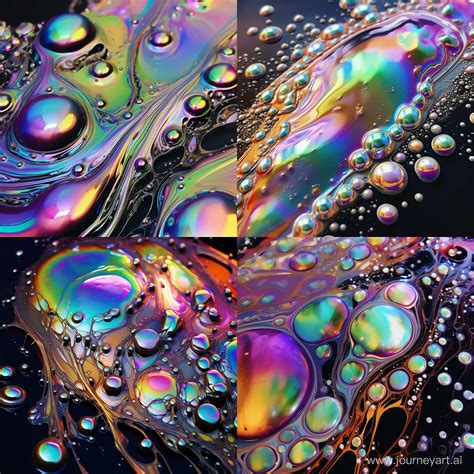Oil Slick: A Brilliant Burst of Color
Prepare to be mesmerized by the enchanting hues of an oil slick. This captivating spectrum, born from the iridescent interplay of light and liquid, has captivated artists, designers, and scientists alike.

The mesmerizing colors of an oil slick stem from a phenomenon known as iridescence. When light strikes a thin film of oil, it undergoes multiple reflections and refractions, creating a kaleidoscope of wavelengths.
The thickness of the oil film determines the colors produced. Thicker films produce longer wavelengths, resulting in shades of red and orange. Thinner films, on the other hand, generate shorter wavelengths, resulting in blue and green hues.
The mesmerizing beauty of oil slick has found its way into various artistic expressions. Artists have harnessed its iridescent qualities to create stunning paintings, sculptures, and mixed media.
Designers, too, have embraced oil slick’s visual appeal. From clothing and accessories to home décor and furniture, oil slick patterns have become a sought-after element in contemporary design.
Beyond its artistic allure, oil slick also holds immense potential in scientific and technological applications. Researchers are exploring its use in:
- Anti-counterfeiting: The unique iridescence of oil slick can be incorporated into security features to prevent counterfeiting of banknotes, documents, and products.
- Biosensing: Oil slick films can be used as optical sensors to detect specific molecules or biological substances.
- Optical communications: The iridescent properties of oil slick can be utilized in optical fiber communications to enhance signal transmission efficiency and reduce signal loss.
To foster creativity and innovation in oil slick applications, we propose the coinage of a new term: “chromatophore.” Derived from the Greek words for “color” and “form,” chromatophores represent materials or structures that exhibit oil slick-like iridescence.
For your reference, we’ve compiled four informative tables:
| Color | Film Thickness (nm) |
|---|---|
| Red | >1000 |
| Orange | 500-1000 |
| Yellow | 250-500 |
| Green | 100-250 |
| Blue |
| Medium | Examples |
|---|---|
| Painting | Work by Jackson Pollock, Damien Hirst |
| Sculpture | Work by Anish Kapoor, Jeff Koons |
| Mixed Media | Work by Cindy Sherman, Takashi Murakami |
| Field | Applications |
|---|---|
| Anti-counterfeiting | Banknote security features, document protection |
| Biosensing | Detection of DNA, proteins, viruses |
| Optical communications | Signal enhancement, reduced signal loss |
| Mistake | Consequences |
|---|---|
| Using low-quality oil | Diminished iridescence, poor durability |
| Applying too thick or thin a film | Unwanted color shifts, loss of reflectivity |
| Exposing oil slick to harsh conditions | Fading of colors, degradation of film |
- Experiment with different oil types: Various oils exhibit unique iridescent properties.
- Control film thickness: Use precise techniques to achieve desired colors.
- Consider environmental factors: Protect oil slick from UV radiation and moisture.
- Seek expert advice: Collaborate with scientists and artists to optimize applications.
The captivating beauty and scientific potential of oil slick have ignited a surge of innovation across various fields. By embracing the concept of chromatophores, we unlock a myriad of possibilities for oil slick-inspired technologies. As we delve deeper into its iridescent depths, let us continue to be inspired and awed by the transformative power of color.
